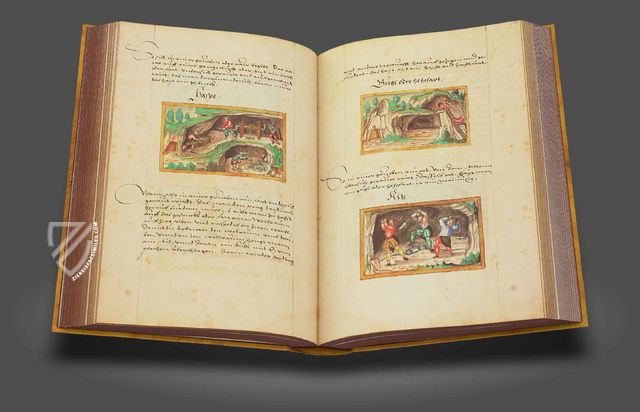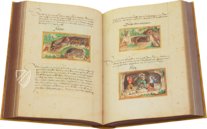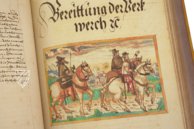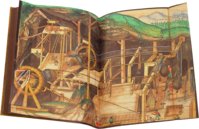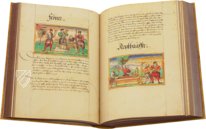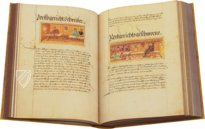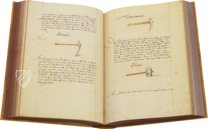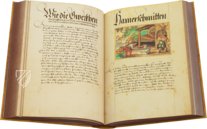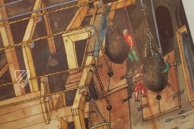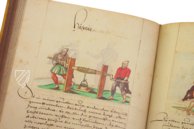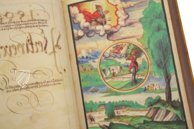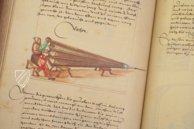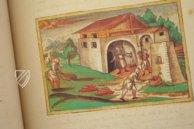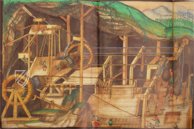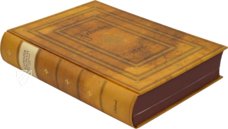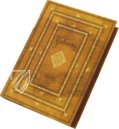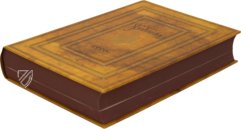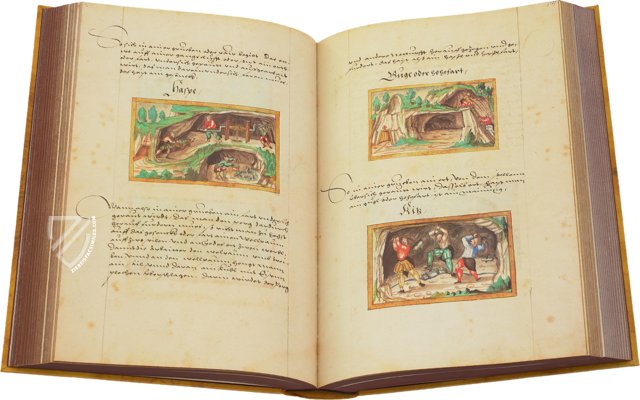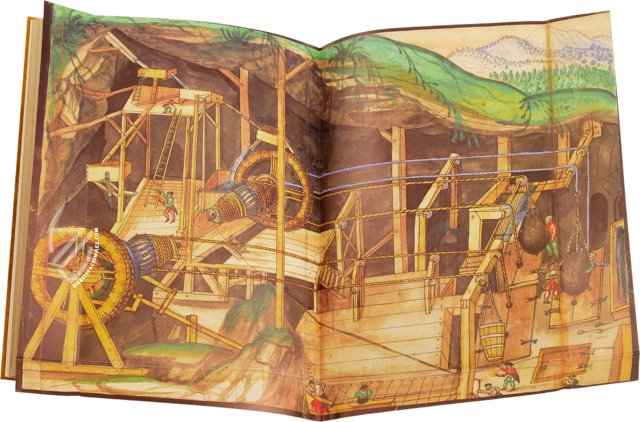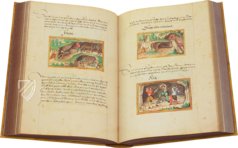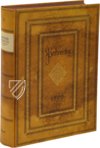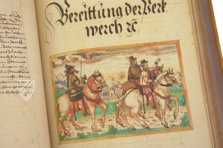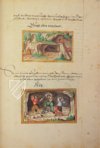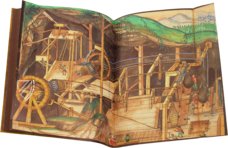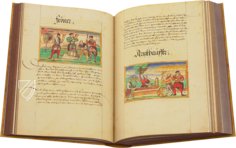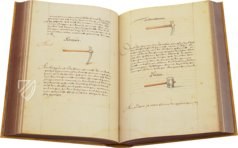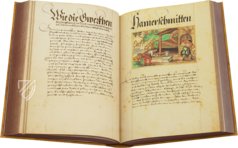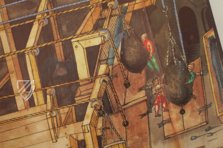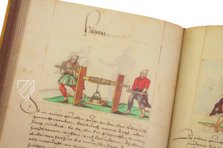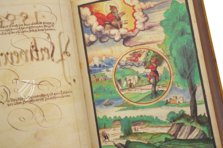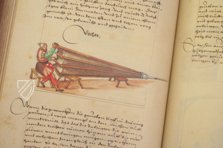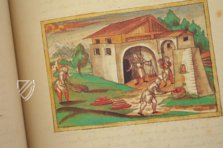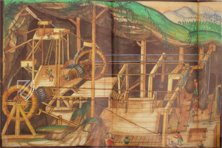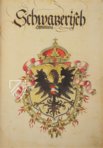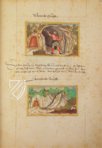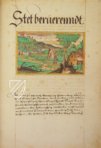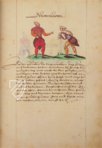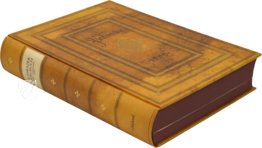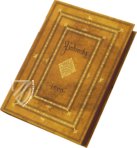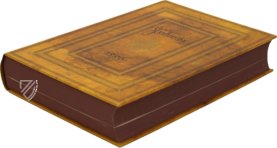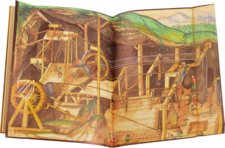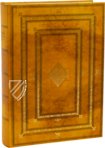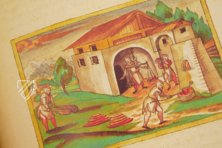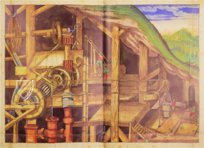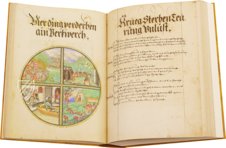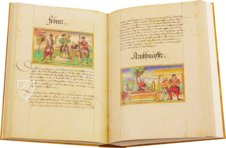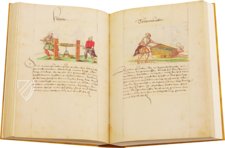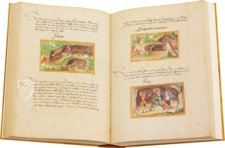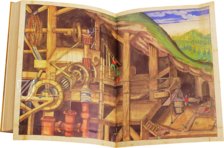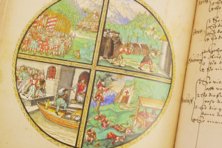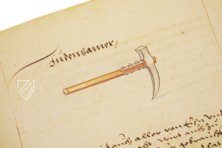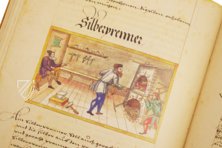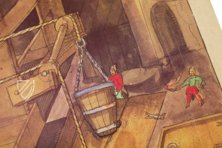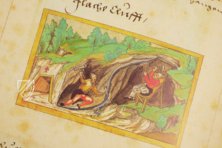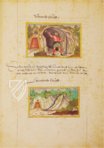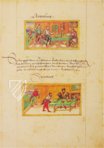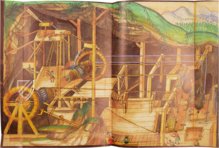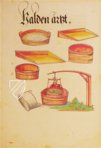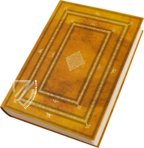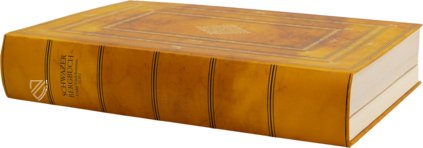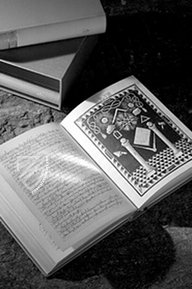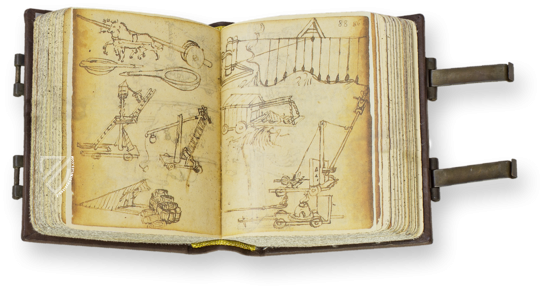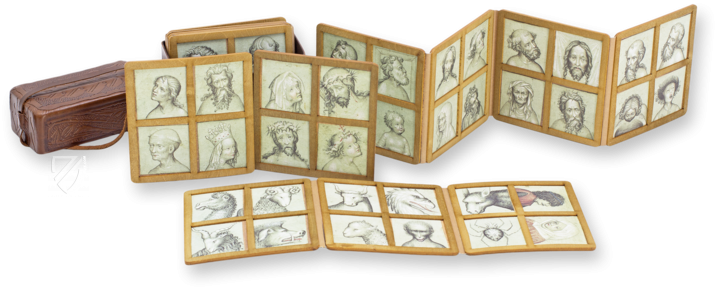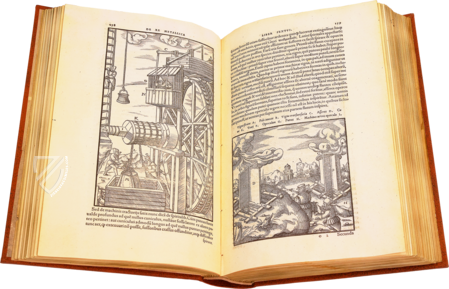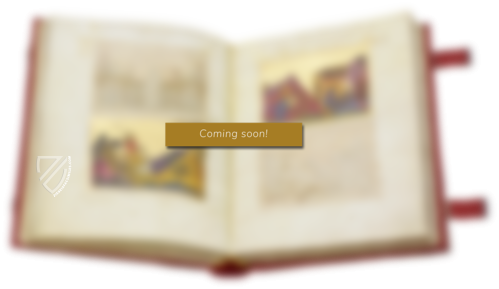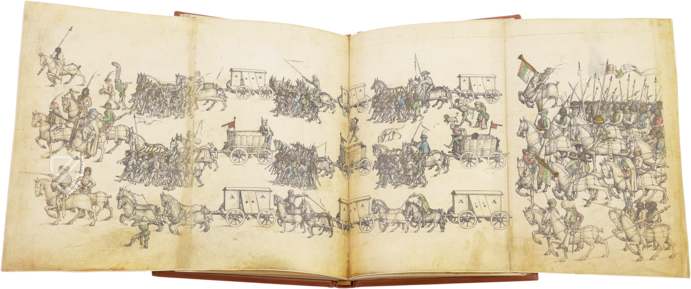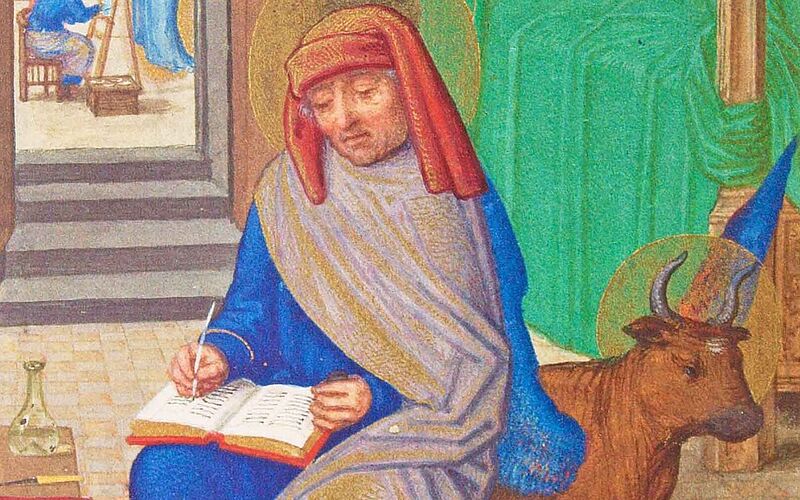Mining Book of Schwaz
(1,000€ - 3,000€)
Aside from being an excellent work of late illumination, the Mining Book of Schwaz also provides an important illustrated source for experts in the humanities and natural sciences of the 16th century. The town of Schwaz grew into the second largest community in Austria in the course of the 15th century and miners were attracted there by its rich silver and copper deposits. Such was its economic importance, that when Emperor Maximilian I ascended to the throne, Schwaz in Tyrol became the financial foundation for his ambitious undertakings. The manuscript addresses every aspect of the mining community, specifying mining law and regulations, equipment and clothing, social hierarchies, and even includes topography with the first illustrations of villages and mountainous landscapes ever made.
Mining Book of Schwaz
This manuscript has had a great influence, not least with art historians for its generous decoration with miniatures. Its significance as an excellent source for mining operations in Tyrolean Schwaz makes the manuscript a precious gem of European scientific literature. With a total of 120 colorful miniatures to support the historic evidence of the text, making it understandable to the reader, the Mining Book of Schwaz also provides an important illustrated source for experts in the humanities and natural sciences of the 16th century. It conveys and illustrates work and social events of everyday life in this period. What's more, the book gives a comprehensive insight into the legal, economic, social, and cultural aspects of mining in the 16th century. The Mining Book of Schwaz contains a reflection on the legendary mines of Schwaz at the end of their heyday. The book was not printed and the few hand-written and illustrated copies were not intended for a wider public but for a small and exclusive circle of readers.
The Oldest German Mining Book
The town of Schwaz became celebrated in the 15th century for its rich silver and copper deposits. Due to its leading position in the mining business, it was called the "mother of all mines". When Emperor Maximilian I ascended to the throne, Schwaz in Tyrol became the financial foundation for his ambitious undertakings. The inflow of miners rapidly turned this Tyrolean village into the community with the second largest population in Austria, after Vienna. The Mining Book of Schwaz was made at a time when mining in Schwaz, after a hundred years of leadership in European metallurgy, had already passed its peak and was going through a major crisis. Written by a high ranking official of the regional mining authority, the Mining Book was probably made to serve a triple purpose: the first intention was to make the Emperor Ferdinand I familiar with his richest resource and to remind him of the role of mining for his economic and political interests. Second, it was intended as an incentive for new investors to buy shares. Third, it was meant to provide a comprehensive overview of the legal and safety aspects of mining in preparation of the mining conference in 1557.
An Invaluable Source for the History of Mining in Schwaz
These three aims are clearly outlined in this book, which is itself divided into four sections. The first section deals with the so-called mining orders. The mining regulations of that period were stricter than in modern times. They not only dealt with property rights and the mining inspectorate but also organized the operation of the mine, environmental, labor and social laws, as well as special mining jurisdiction. In the second comprehensive section the reader finds material on mining in general and on special matters, recommendations to the sovereign, instructions for different tasks as well as descriptions of the mining operations in Schwaz, in addition to the duties of the mining official, as well as duties and remuneration of the miners. The third section provides an illustrated encyclopedia on mining, the oldest of its kind, including colorful illustrations of work in progress and equipment used as well as practice-oriented descriptions. The fourth section is a compilation of the jurisdiction practice of the mining court in Schwaz, including important judgements, procedural instructions and remarks on how a miner had to appear before court.
The Miniatures
Apart from the explanation of Mining Law and a whole range of remarkable features illustrating the exploitation of the Schwaz deposits, the position of miners in society and their hierarchy, the intrinsic meaning of the accompanying text is of great value. The finely colored pen and ink drawings illustrate the multiple mining tasks and give us a lively impression of the machinery and clothing of miners and the robes worn at court by high officials. The views of the exploited areas in the foldout illustrations are of eminent significance for topography, as they are the first illustrations of villages and mountainous landscapes ever made. When compared to the famous mining textbook of Agricola (De re metallica libri XII, printed in 1556), which essentially describes the contemporary state of the art in mining technology, the Mining Book of Schwaz fascinates by its comprehensive illustration of mining in all its aspects and its colorful illustrations.
Codicology
- Alternative Titles
- Das Schwazer Bergbuch
- Size / Format
- 396 pages / 34.0 × 24.0 cm
- Origin
- Austria
- Date
- 1556–1561
- Epochs
- Style
- Language
- Illustrations
- 120 colorful miniatures
Mining Book of Schwaz
Exploiting a Silver Vein
This pen and ink drawing shows a cave containing three miners, two with sledgehammers and one with a long prybar, driving wedges into the ground with the hope of getting to the rich vein of silver they have found. In this dynamic scene, the artist has emphasized the fact that the two men on the left and right are in mid-swing by showing the handles of their sledgehammers bending. All three men are brightly dressed, but their pants are worn and ripped.
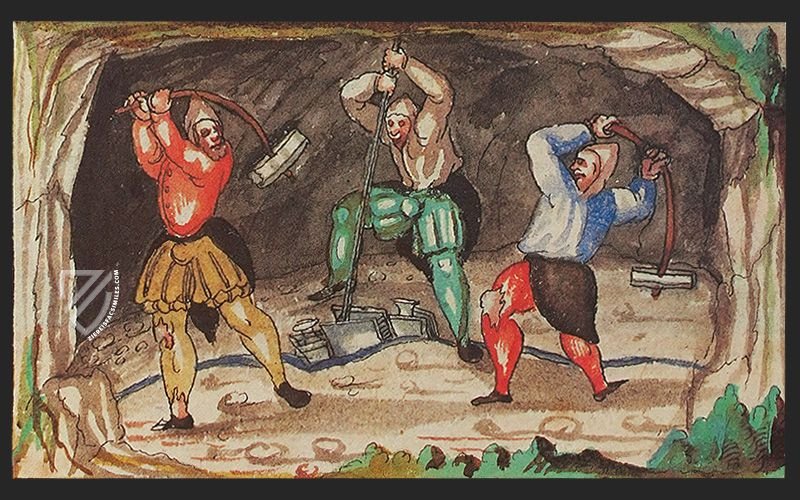
Mining Book of Schwaz
Silver Mine
This richly colored double page miniature (including a third foldout section) shows the impressive machinery used in the Schwaz silver mine inside of the mountain. In the upper-left corner, an underground stream has been rerouted to turn the two giant water wheels that in turn power cranes raising and lowering buckets and sacks full of silver ore for the miners.
This is an extraordinary and innovative miniature that was executed with the greatest artistry and realism. Set within an Alpine landscape, it looks as though the artist has sliced away the mountainside to reveal the vast interior space, complete with supporting columns to keep the mine from collapsing. The attention to detail in depicting the mechanical devises is equally impressive.
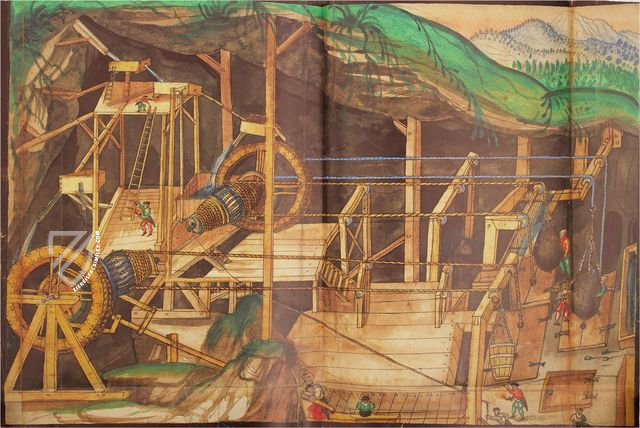
#1 Das Schwazer Bergbuch
Language: German
(1,000€ - 3,000€)
#2 Das Schwazer Bergbuch
Language: German
(under 1,000€)
- Treatises / Secular Books
- Apocalypses / Beatus
- Astronomy / Astrology
- Bestiaries
- Bibles / Gospels
- Chronicles / History / Law
- Geography / Maps
- Saints' Lives
- Islam / Oriental
- Judaism / Hebrew
- Single Leaf Collections
- Leonardo da Vinci
- Literature / Poetry
- Liturgical Manuscripts
- Medicine / Botany / Alchemy
- Music
- Mythology / Prophecies
- Psalters
- Other Religious Books
- Games / Hunting
- Private Devotion Books
- Other Genres
- Afghanistan
- Armenia
- Austria
- Belgium
- Belize
- Bosnia and Herzegovina
- China
- Colombia
- Costa Rica
- Croatia
- Cyprus
- Czech Republic
- Denmark
- Egypt
- El Salvador
- Ethiopia
- France
- Germany
- Greece
- Guatemala
- Honduras
- Hungary
- India
- Iran
- Iraq
- Israel
- Italy
- Japan
- Jordan
- Kazakhstan
- Kyrgyzstan
- Lebanon
- Liechtenstein
- Luxembourg
- Mexico
- Morocco
- Netherlands
- Palestine
- Panama
- Peru
- Poland
- Portugal
- Romania
- Russia
- Serbia
- Spain
- Sri Lanka
- Sweden
- Switzerland
- Syria
- Tajikistan
- Turkey
- Turkmenistan
- Ukraine
- United Kingdom
- United States
- Uzbekistan
- Vatican City
- A. Oosthoek, van Holkema & Warendorf
- Aboca Museum
- Ajuntament de Valencia
- Akademie Verlag
- Akademische Druck- u. Verlagsanstalt (ADEVA)
- Aldo Ausilio Editore - Bottega d’Erasmo
- Alecto Historical Editions
- Alkuin Verlag
- Almqvist & Wiksell
- Amilcare Pizzi
- Andreas & Andreas Verlagsbuchhandlung
- Archa 90
- Archiv Verlag
- Archivi Edizioni
- Arnold Verlag
- ARS
- Ars Magna
- ArtCodex
- AyN Ediciones
- Azimuth Editions
- Badenia Verlag
- Bärenreiter-Verlag
- Belser Verlag
- Belser Verlag / WK Wertkontor
- Benziger Verlag
- Bernardinum Wydawnictwo
- BiblioGemma
- Biblioteca Apostolica Vaticana (Vaticanstadt, Vaticanstadt)
- Bibliotheca Palatina Faksimile Verlag
- Bibliotheca Rara
- Boydell & Brewer
- Bramante Edizioni
- Bredius Genootschap
- Brepols Publishers
- British Library
- C. Weckesser
- Caixa Catalunya
- Canesi
- CAPSA, Ars Scriptoria
- Caratzas Brothers, Publishers
- Carus Verlag
- Casamassima Libri
- Centrum Cartographie Verlag GmbH
- Chavane Verlag
- Christian Brandstätter Verlag
- Circulo Cientifico
- Club Bibliófilo Versol
- Club du Livre
- CM Editores
- Collegium Graphicum
- Collezione Apocrifa Da Vinci
- Comissão Nacional para as Comemorações dos Descobrimentos Portugueses
- Coron Verlag
- Corvina
- CTHS
- D. S. Brewer
- Damon
- De Agostini/UTET
- De Nederlandsche Boekhandel
- De Schutter
- Deuschle & Stemmle
- Deutscher Verlag für Kunstwissenschaft
- DIAMM
- Droz
- E. Schreiber Graphische Kunstanstalten
- Ediciones Boreal
- Ediciones Grial
- Ediclube
- Edições Inapa
- Edilan
- Editalia
- Edition Deuschle
- Edition Georg Popp
- Edition Leipzig
- Edition Libri Illustri
- Editiones Reales Sitios S. L.
- Éditions de l'Oiseau Lyre
- Editions Medicina Rara
- Editorial Casariego
- Editorial Mintzoa
- Editrice Antenore
- Editrice Velar
- Edizioni Edison
- Egeria, S.L.
- Eikon Editores
- Electa
- Emery Walker Limited
- Enciclopèdia Catalana
- Eos-Verlag
- Ephesus Publishing
- Ernst Battenberg
- Eugrammia Press
- Extraordinary Editions
- Fackelverlag
- Facsimila Art & Edition
- Facsimile Editions Ltd.
- Facsimilia Art & Edition Ebert KG
- Faksimile Verlag
- Feuermann Verlag
- Folger Shakespeare Library
- Franco Cosimo Panini Editore
- Friedrich Wittig Verlag
- Fundación Hullera Vasco-Leonesa
- G. Braziller
- Gabriele Mazzotta Editore
- Gebr. Mann Verlag
- Gesellschaft für graphische Industrie
- Getty Research Institute
- Giovanni Domenico de Rossi
- Giunti Editore
- Graffiti
- Grafica European Center of Fine Arts
- Guido Pressler
- Guillermo Blazquez
- Gustav Kiepenheuer
- H. N. Abrams
- Harrassowitz
- Harvard University Press
- Helikon
- Hendrickson Publishers
- Henning Oppermann
- Herder Verlag
- Hes & De Graaf Publishers
- Hoepli
- Holbein-Verlag
- Houghton Library
- Hugo Schmidt Verlag
- Idion Verlag
- Il Bulino, edizioni d'arte
- ILte
- Imago
- Insel Verlag
- Insel-Verlag Anton Kippenberger
- Instituto de Estudios Altoaragoneses
- Instituto Nacional de Antropología e Historia
- Introligatornia Budnik Jerzy
- Istituto dell'Enciclopedia Italiana - Treccani
- Istituto Ellenico di Studi Bizantini e Postbizantini
- Istituto Geografico De Agostini
- Istituto Poligrafico e Zecca dello Stato
- Italarte Art Establishments
- Jan Thorbecke Verlag
- Johnson Reprint Corporation
- Josef Stocker
- Josef Stocker-Schmid
- Jugoslavija
- Karl W. Hiersemann
- Kasper Straube
- Kaydeda Ediciones
- Kindler Verlag / Coron Verlag
- Kodansha International Ltd.
- Konrad Kölbl Verlag
- Kurt Wolff Verlag
- La Liberia dello Stato
- La Linea Editrice
- La Meta Editore
- Lambert Schneider
- Landeskreditbank Baden-Württemberg
- Leo S. Olschki
- Les Incunables
- Liber Artis
- Library of Congress
- Libreria Musicale Italiana
- Lichtdruck
- Lito Immagine Editore
- Lumen Artis
- Lund Humphries
- M. Moleiro Editor
- Maison des Sciences de l'homme et de la société de Poitiers
- Manuscriptum
- Martinus Nijhoff
- Maruzen-Yushodo Co. Ltd.
- MASA
- Massada Publishers
- McGraw-Hill
- Metropolitan Museum of Art
- Militos
- Millennium Liber
- Müller & Schindler
- Nahar - Stavit
- Nahar and Steimatzky
- National Library of Wales
- Neri Pozza
- Nova Charta
- Oceanum Verlag
- Odeon
- Orbis Mediaevalis
- Orbis Pictus
- Österreichische Staatsdruckerei
- Oxford University Press
- Pageant Books
- Parzellers Buchverlag
- Patrimonio Ediciones
- Pattloch Verlag
- PIAF
- Pieper Verlag
- Plon-Nourrit et cie
- Poligrafiche Bolis
- Presses Universitaires de Strasbourg
- Prestel Verlag
- Princeton University Press
- Prisma Verlag
- Priuli & Verlucca, editori
- Pro Sport Verlag
- Propyläen Verlag
- Pytheas Books
- Quaternio Verlag Luzern
- Reales Sitios
- Recht-Verlag
- Reichert Verlag
- Reichsdruckerei
- Reprint Verlag
- Riehn & Reusch
- Roberto Vattori Editore
- Rosenkilde and Bagger
- Roxburghe Club
- Salerno Editrice
- Saltellus Press
- Sandoz
- Sarajevo Svjetlost
- Schöck ArtPrint Kft.
- Schulsinger Brothers
- Scolar Press
- Scrinium
- Scripta Maneant
- Scriptorium
- Shazar
- Siloé, arte y bibliofilia
- SISMEL - Edizioni del Galluzzo
- Sociedad Mexicana de Antropología
- Société des Bibliophiles & Iconophiles de Belgique
- Soncin Publishing
- Sorli Ediciones
- Stainer and Bell
- Studer
- Styria Verlag
- Sumptibus Pragopress
- Szegedi Tudomànyegyetem
- Taberna Libraria
- Tarshish Books
- Taschen
- Tempus Libri
- Testimonio Compañía Editorial
- Thames and Hudson
- The Clear Vue Publishing Partnership Limited
- The Facsimile Codex
- The Folio Society
- The Marquess of Normanby
- The Richard III and Yorkist History Trust
- Tip.Le.Co
- TouchArt
- TREC Publishing House
- TRI Publishing Co.
- Trident Editore
- Tuliba Collection
- Typis Regiae Officinae Polygraphicae
- Union Verlag Berlin
- Universidad de Granada
- University of California Press
- University of Chicago Press
- Urs Graf
- Vallecchi
- Van Wijnen
- VCH, Acta Humaniora
- VDI Verlag
- VEB Deutscher Verlag für Musik
- Verlag Anton Pustet / Andreas Verlag
- Verlag Bibliophile Drucke Josef Stocker
- Verlag der Münchner Drucke
- Verlag für Regionalgeschichte
- Verlag Styria
- Vicent Garcia Editores
- W. Turnowski Ltd.
- W. Turnowsky
- Waanders Printers
- Wiener Mechitharisten-Congregation (Wien, Österreich)
- Wissenschaftliche Buchgesellschaft
- Wissenschaftliche Verlagsgesellschaft
- Wydawnictwo Dolnoslaskie
- Xuntanza Editorial
- Zakład Narodowy
- Zollikofer AG

